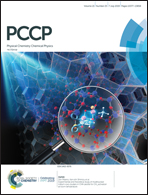Revealing the mechanistic pathway of cholinergic inhibition of Alzheimer's disease by donepezil: a metadynamics simulation study†
Abstract
Donepezil, an acetylcholinesterase inhibitor, is an approved drug for the symptomatic treatment of Alzheimer's disease (AD). The mechanistic pathway for the inhibition mechanism of acetylcholinesterase (AChE) by donepezil is not well explored. We report for the first time, the inhibition mechanism of AChE by the donepezil drug molecule for the hydrolysis of acetylcholine (ACh) with docking and well-tempered metadynamics (WTMtD) simulations with a human acetylcholinesterase (hAChE) crystal structure (4EY7). This study explored the orientation of the donepezil drug molecule inside the gorge of AChE. The 1D free energy surface obtained from WTMtD simulation studies reveals that the orientation of donepezil in the crystal donepezil (−87.25 kJ mol−1) is energetically more favored than the other orientation of donepezil (−74.74 kJ mol−1) for inhibition of AChE. The free energy landscape computation for the two sets of CVs further corroborates the 1D free energy surface. The WTMtD simulation performed with the crystal structure of donepezil bound hAChE gives the conformation of donepezil at Basin-I as similar to the conformation of donepezil observed in the crystal structure (4EY7). The WTMtD simulations further reveal that the bridged water molecules are more ordered near the catalytic triad of AChE to deter the nucleophilicity of Ser203 through intermolecular hydrogen bonding when donepezil approaches near to the active site gorge of AChE. The presence of donepezil near the active site of AChE can inhibit its approach for ACh hydrolysis; this is revealed through the docking study, where the drug molecule inside the active gorge of hAChE restricts the approach of ACh to Ser203 for the hydrolysis process.



 Please wait while we load your content...
Please wait while we load your content...